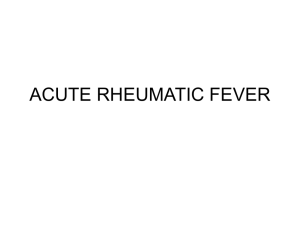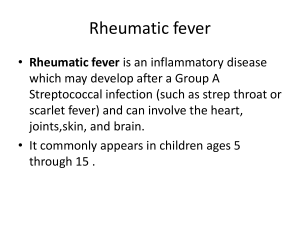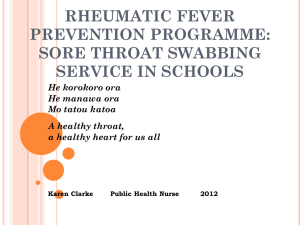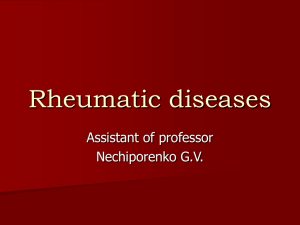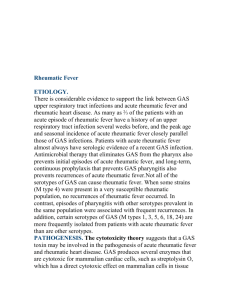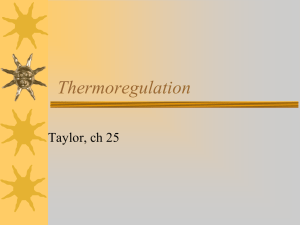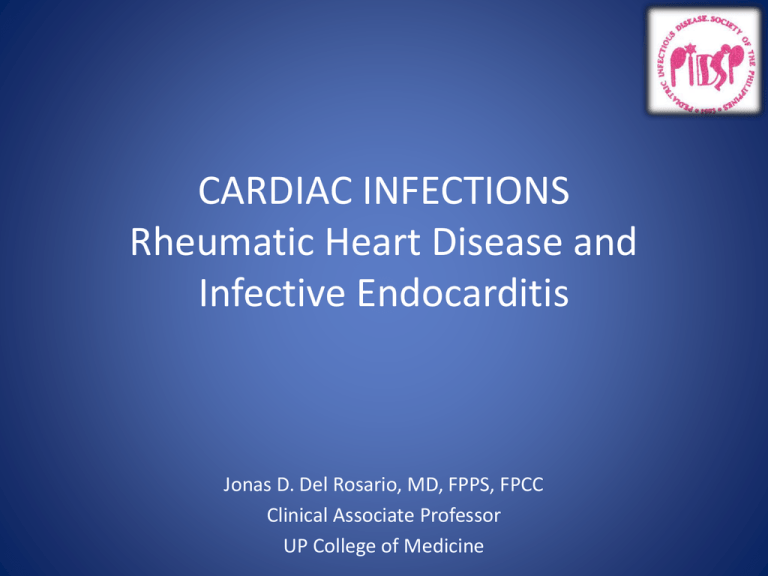
CARDIAC INFECTIONS
Rheumatic Heart Disease and
Infective Endocarditis
Jonas D. Del Rosario, MD, FPPS, FPCC
Clinical Associate Professor
UP College of Medicine
RHEUMATIC FEVER
RHEUMATIC HEART DISEASE
RF to RHD
“Rheumatic Fever is a disease the LICKS the
joints but BITES heart.”
RHD IS THE MOST SERIOUS COMPLICATION OF
RF
Rheumatic Fever
• Most common cause of acquired heart
disease in children & young adults
worldwide
• Diffuse inflammation of connective
tissues of heart, joints, brain, blood
vessels & subcutaneous tissues
• Rheumatic process causes fibrosis of
heart valves leading to RHD
Epidemiology
• Incidence of RF and RHD has not decreased in
developing countries
• Rheumatic Fever is principally a disease of
childhood, with a median age of 10 years,
although is also occurs in adults
• Remains a major cause of morbidity and
mortality in country
Acute Rheumatic Fever
Age and Sex Distribution ( N = 117 )
Frequency
30
25
20
Male
Female
15
10
5
0
Age
Years
<2
2-3
4-5
6-7
8-9
10-11 12-13 14-15 >16
PGH – Pedia 1986-90
Rheumatic Fever & Rheumatic
Heart Disease
Prevalence in school children:
Developing countries
Philippines
1971-1980
1981-1990
18.6 / 1000
0.9 / 1000
0.6 / 1000
Developed countries
USA
1971-1980
Australia
1981-1990
0.7 / 1000
12.3 / 1000
Group A β-Hemolytic Streptococcus
(GAS)
• Capsule
– Non-antigenic
• Cell wall
– M-protein
– Induces antibodies
– Serotypes 5, 6, & 19 cross react with myosin
Streptococcal Tonsillopharyngitis
Pathophysiology
• Rheumatic fever develops in some children
and adolescents following PHARYNGITIS with
a group A beta-hemolytic Streptococcus
(Streptococcus pyogenes)
• The organisms attach to the epithelial cells of
the upper respiratory tract and produce a
battery of enzymes allowing them to damage
and invade human tissues
Group A β-Hemolytic Streptococcus
(GAS)
• Enzymes
– Streptolysin
– Deoxyribonuclease
– Fibrinolysin
– Diphosphopyridine nucleotidase
– Hyaluronidase
Rheumatic Fever:
Pathogenesis
• Actual mechanism unknown
• Postulate:
– Autoimmune or hypersensitivity reaction to
GAS produces pathogenic autoantibodies
to cardiac tissues
Pathophysioloy
• In 0.3-3% of cases, streptococcal pharyngitis
leads to rheumatic fever several weeks after
the sore throat has resolved.
• Only infections of the pharynx initiate or
reactivate rheumatic fever.
• Organism spreads by direct contact with oral
or respiratory secretions
• Patient remains infected for weeks after
symptomatic resolution of pharyngitis
Fever in ARF
• Full manifestations of the disease may be
suppressed if patient has previously taken
aspirin or other NSAIDs
• Fever above 39° C with no characteristic
pattern are initially present in almost every
case of acute rheumatic fever
• Fever may be low grade in children with mild
carditis or absent in patients with chorea
• Low grade fevers persists for 2-3 weeks
DIAGNOSIS
• A diagnosis of RHD is made after confirming
antecedent rheumatic fever
• The JONES criteria require the presence of 2
major or 1 major and 2 minor criteria for the
diagnosis of RF
• Additional evidence of previous group A
streptococcal pharyngitis is required
Jones Criteria 1992
• Establish initial attack of acute
rheumatic fever
• Not intended
– To establish diagnosis of inactive or
chronic RHD
– To measure rheumatic activity
– To predict course or severity of disease
• Previous RF or RHD not included as
manifestation
Jones Criteria 1992 for
Acute Rheumatic Fever
Major manifestations
• Carditis
• Polyarthritis
• Chorea
• Erythema
marginatum
• Subcutaneous
nodules
Minor manifestations
• Fever
• Arthralgia
• ↑ acute phase
reactants
• Prolonged PR interval
Cardiac Manifestions of ARF
• Carditis is most commonly detected by a new
murmur and tachycardia out of proportion to
fever
• New or changing murmurs are considered
necessary for a diagnosis of rheumatic
valvulitis
Acute RF w Carditis
• Acute rheumatic heart disease often produces
a pancarditis (endocarditis, myocarditis and
pericarditis)
• Mitral valve is most commonly and severely
affected, followed by the aortic valve
Rheumatic Carditis
• Valvulitis
–
–
–
–
–
•
•
•
•
•
Almost always present
Apical systolic murmur (Mitral regurgitation)
Apical mid-diastolic murmur (Carey-Coomb’s)
Basal diastolic murmur (Aortic regurgitation)
Basal systolic murmur (Tricuspid regurgitation)
Resting tachycardia
Muffled heart sounds
Gallop rhythm
Pericardial friction rub
Congestive heart failure
“Echocarditis”
• Some cardiologists have proposed that echoDoppler evidence of mitral insufficiency,
particularly in association with aortic
insufficiency, may be sufficient for a diagnosis
of carditis (even in the absence of
accompanying auscultatory findings)
“Echocarditis”
• Echocardiographic findings in acute
rheumatic fever (mitral regurgitation and/or
aortic regurgitation) in the absence of
clinical carditis
• Subclinical carditis
• Included as basis for carditis in modified
Jones criteria?
• Controversial
Jones Criteria 1992
High probability of rheumatic fever :
• 2 major or
• 1 major & 2 minor manifestations
PLUS Evidence of GAS
infection
Evidence of Antecedent Group A
Streptococcal Infections
• ↑ or rising Streptococcal antibody
(ASO) titer
• (+) throat culture or rapid antigen test
Antistreptococcal antibodies
• Clinical features of RF begin at the time
antistreptococcal antibodies are at their peak
• Useful for confirming previous group A
streptococcal infection
• ASO is the most commonly used
• Sensitivity can be improved by testing for
several antibodies (ASO, antiDNase,
antihyalarunidase etc.)
Antistreptococcal
Antibody Titers
• Reflect past & not present immunologic
events
• No value in the diagnosis of acute
pharyngitis
• Valuable for confirmation of previous
streptococcal infections in patients
suspected of having acute RF or PSGN
• Helpful, in prospective epidemiological
studies, for distinguishing patients with
acute infection from patients who are
carriers
ASO titer
• Peaks 2-3 weeks after the onset of rheumatic
fever
• Plateaus for 3-6 months
• Returning to normal levels after 6-12 months
• Antihyaluronidase results are frequently
abnormal in RF patients with normal level ASO
titer and may rise earlier and persist longer
than ASO during RF
Rheumatic Fever
Laboratory Examinations
• CBC
– Anemia ; Leukocytosis
• ECG
–
–
–
–
Sinus tachycardia
1o AV block
No chamber enlargement
Rarely 2o AV block, low voltages, ST-T wave
changes
• CXR
– Normal
– Cardiomegaly
– Pulmonary congestion to edema
Acute Phase Reactants
• C reactive protein and ESR
– Elevated in RF due to inflammatory in nature
– Both have a high sensitivity but low specificity
– May be used to monitor the resolution of
inflammation, detect relapse when weaning
aspirin or identify recurrence of disease
Chest X-ray
• Chest X-ray
– Cardiomegaly may or may not be present
– Pulmonary congestion in congestive heart failure
Rheumatic Carditis
• Mild carditis – No cardiomegaly
• Moderate carditis – mild cardiomegaly
• Severe carditis – cardiomegaly with
severe pulmonary congestion or edema
Rheumatic Carditis
Chest radiograph of an 8 year old patient with acute
carditis before treatment
Rheumatic Carditis
Same patient after 4 weeks
ECHOCARDIOGRAPHY
• Is the imaging of choice to detect the
presence of rheumatic carditis or rheumatic
heart disease
• If the ECHO is normal, diagnosis of RHD is
ruled out
Rheumatic Fever :
Echocardiographic Findings
• Focal nodular thickening of valves
• Prolapsed Anterior mitral valve leaflet
• Left chambers enlargement ; normal
function
• Pericardial effusion
• Valvular regurgitation – valves involved &
severity
Ty & Ortiz. Cardiol in the Young 2(3): 229-35, July 1992.
RHD - Mitral Regurgitation
Figure 2. Significant regurgitation with the use of WHO criteria for subclinical RHD (left
parasternal long-axis view).
Marijon E et al. Circulation 2009;120:663-668
Copyright © American Heart Association
Figure 3. Echocardiographic findings of subclinical RHD with the use
of combined criteria (left parasternal long-axis view).
Marijon E et al. Circulation 2009;120:663-668
Copyright © American Heart Association
Echocardiogram
• Color doppler-echocardiography identifies and
quantitates valve insufficiency and ventricular
function
• Mild carditis -- mild regurgitation during acute
phase but resolves in weeks to months
• Moderate-severe carditis – persistent
mitral/aortic regurgitation
Rheumatic Mitral Regurgitation
• The most important echocardiographic
features of mitral regurgitation from acute
rheumatic valvulitis are annular dilatation,
elongation of the chordae to the anterior
leaflet, and a posterolaterally directed mitral
regurgitation
Echocardiography in RHD
• Acute Rheumatic Fever – Left ventricle is
frequently dilated in association with normal
or increases fractional shortening
• Chronic rheumatic heart disease – Affected
leaflets become diffusely thickened with
fusion of commissures and chordae tendinae;
calcifications may be seen
Rheumatic Heart Disease
Chronic valvar heart disease as a
sequelae of rheumatic fever
and its recurrences
RHD Mitral Stenosis
Stenotic mitral valve seen from
left atrium. Both commissures are
fused; the cusps are severely
thickened. The left atrium is huge.
The valve is both incompetent &
stenotic
RHD Mitral Stenosis
Rheumatic Carditis
Aortic valve showing active valvulitis. The valve is slightly
thickened and displays small vegetations – "verrucae”
Rheumatic Fever : Management
• Antibiotic: to eradicate Streptococcus
– PCN VK
- 250 – 500 mg TID x 10d
– Benzathine PCN - 0.6 – 1.2 MU IM
– Erythromycin
- 250mg TID x 10d
• Anti-inflammatory agents: 6 – 8 weeks
– ASA
- 100 mg/kg/day
– Prednisone - 2 mg/kg/day
• Complete bed rest & modified activity
GAS Tonsillitis:
Rheumatic Attack Rate
• 0.3% - GAS tonsillitis treated with PCN
• 3% - GAS tonsillitis untreated
• 60% - known rheumatic patients with GAS
tonsillitis
Rheumatic Fever : Management
• Prophylaxis
– 1o - prevents 1st episode of RF
– 2o - prevents recurrences of RF
• PCN VK 250 mg BID
• Benzathine PCN 1.2 MU q 21 – 28 days
– Duration of 2o prophylaxis
• Arthritis - at least 5 years
• Carditis - at least 10 years
(recurrence
free & no residual heart disease)
Treatment of GAS Pharyngitis &
1o Prevention of RF
BONOW ET AL., ACC/AHA TASK FORCE REPORT
JACC Vol. 32, No. 5, November 1998:1486-1588
ACC/AHA Guidelines for the Management of Patients With Valvular Heart Disease
BONOW ET AL., ACC/AHA TASK FORCE REPORT
JACC Vol. 32, No. 5, November 1998:1486-1588
ACC/AHA Guidelines for the Management of Patients With Valvular Heart Disease
BONOW ET AL., ACC/AHA TASK FORCE REPORT
JACC Vol. 32, No. 5, November 1998:1486-1588
ACC/AHA Guidelines for the Management of Patients With Valvular Heart Disease
BONOW ET AL., ACC/AHA TASK FORCE REPORT
JACC Vol. 32, No. 5, November 1998:1486-1588
ACC/AHA Guidelines for the Management of Patients With Valvular Heart Disease
Penicillin for 2nd Prophylaxis of Rheumatic
Fever
• Meta-analysis by Manyemba & Mayosi
[
Cochrane Library (1) 2003]
• 9 RCT & quasi-RCT with 3008 subjects ;
methodological quality poor
• IM Penicillin more effective than oral penicllin
• 2 weekly or 3 weekly injections more effective
than 4 weekly injections
INFECTIVE ENDOCARDITIS
Infective Endocarditis
• Infection of the endocardium and/or heart
valves that involves thrombus formation
(vegetation) , which may damage the
endocardial tissue and/or valves
• Many aspects of IE are similar in children and
adults, but there are some manifestations that
are unique to children
Epidemiology
• IE occurs less often in children than in adults and
accounts for ≈1 in 1280 pediatric admissions per
year
• Frequency of endocarditis among children
seems to have increased in recent years.
• This is due in part to improved survival among
children who are at risk for endocarditis, such as
those with CHD and hospitalized newborn
infants.
Epidemiology
• Most children with IE have an identifiable risk
factor for disease
• Children with CHD have the highest risk of
developing IE.
• The risk is increased in patients with complex
cyanotic heart disease, especially those who
undergo surgical procedures that introduce
prosthetic material (conduits and shunts)
Risk Factors
•
•
•
•
•
•
•
Congenital Heart Defects
Rheumatic Heart Disease
Intravascular shunts/conduits/prosthesis
Intravascular catheters
IV drug abuse
Prematurity
Immunocompromise
Pathogenesis
• IE is due to a series of complex interactions
among blood borne pathogens, damaged
cardiac endothelium, fibrin and platelets that
result in the formation of an infected
thrombus (vegetation) and damage to
endocardium and/or heart valves.
Pathophysiology
1. Turbulent blood flow disrupts the
endocardium making it “sticky”
2. Bacteremia delivers the organisms to the
endocardial surface
3. Adherence of the organisms to the
endocardial surface
4. Eventual invasion of the valvular leaflets
Infecting Organisms
• Common bacteria
– S. aureus
– Viridans group streptococci
– Enterococci
• Not so common bacteria
– Fungi*
– Coagulase negative staph*
– Pseudomonas
– HACEK
*Common in neonates
Clinical Presentation
• Variable
• Dependent upon the extent of the local
cardiac disease
• Degree of involvement of other organs (eg
embolization)
• Causative agent
Clinical Presentation
• Acute
– Affects normal heart
valves
– Rapidly destructive
– Metastatic foci
– Commonly Staph.
– If not treated, usually
fatal within 6 weeks
• Subacute
– Often affects damaged
heart valves
– Indolent nature
– If not treated, usually
fatal by one year
– Usually Viridans strep
Clinical Presentation
• Acute
– High grade fever and
chills
– Severely ill
– Hemodynamically
unstable
• Subacute
–
–
–
–
–
Low grade fever
Anorexia
Weight loss
Exercise intolerance
Diaphoresis
The onset of symptoms is usually ~2 weeks or less
from the initiating bacteremia
Local Spread of Infection
Acute S. aureus IE with perforation of the
aortic valve and aortic valve vegetations.
Acute S. aureus IE with mitral valve ring
abscess extending into myocardium.
Signs
• Fever
• Heart murmur (“new” or “changing”)
• Nonspecific signs – petechiae, subungal or
“splinter” hemorrhages, clubbing,
splenomegaly, neurologic changes
• More specific signs - Osler’s Nodes, Janeway
lesions, and Roth Spots (not common in
children)
Petechiae
1. Nonspecific
2. Often located on extremities
or mucous membranes
dermatology.about.com/.../
blpetechiaephoto.htm
Photo credit, Josh Fierer, M.D.
medicine.ucsd.edu/clinicalimg/ Eye-Petechiae.html
Harden Library for the Health Sciences
www.lib.uiowa.edu/ hardin/
md/cdc/3184.html
Splinter Hemorrhages
1.
2.
3.
4.
Nonspecific
Nonblanching
Linear reddish-brown lesions found under the nail bed
Usually do NOT extend the entire length of the nail
Janeway Lesions
1.
2.
3.
4.
More specific
Erythematous, blanching macules
Nonpainful
Located on palms and soles
Osler’s Nodes
American College of Rheumatology
webrheum.bham.ac.uk/.../ default/pages/3b5.htm
1.
2.
3.
4.
www.meddean.luc.edu/.../
Hand10/Hand10dx.html
More specific
Painful and erythematous nodules
Located on pulp of fingers and toes
More common in subacute IE
Making the Diagnosis
• Pelletier and Petersdorf criteria (1977)
– Classification scheme of definite, probable, and possible IE
– Reasonably specific but lacked sensitivity
• Von Reyn criteria (1981)
– Added “rejected” as a category
– Added more clinical criteria
– Improved specificity and clinical utility
• Duke criteria (1994)
– Included the role of echocardiography in diagnosis
– Added IVDA as a “predisposing heart condition”
Modified Duke’s Criteria
The clinical diagnosis of IE is made by fulfilling
the modified Duke’s criteria which is based upon
physical and echocardiogram
Duke’s Modified Criteria
MAJOR
• Positive blood culture
• Positive Echocardiogram
– Oscillating intracardiac mass
– Absces
– Dehiscence of prosthetic
valve
MINOR
• Predisposing Heart Condition
• Fever
• Vascular phenomena
–
–
–
–
Major arterial emboli
Septic pulmonary infarcts
Janeway lesions
Conjunctival hemorrhage
• New Valvular Regurgitation • Immunologic phenomena
– Glomerulonephritis
– Osler’s nodes
– Roth spots
Modified Duke’s Criteria
Definite IE
2 Major or
1 Major 3 Minor or
5 Minor critera
Possible IE
1 Major and 1 Minor or
3 Minor
Rejected IE
Resolution of illness with four days or less of antibiotics
LABORATORY TESTS
• Blood Cultures
– Minimum of three blood cultures
– Three separate venipuncture sites
– Obtain 1-3ml in infants and 5-7mL in children
– Bacteremia is continuous so sampling can be done anytime without
relation to the fever
• Positive Result
– Typical organisms present in at least 2 separate samples
– Persistently positive blood culture (atypical organisms)
• Two positive blood cultures obtained at least 12 hours apart
• Three or a more positive blood cultures in which the first and last
samples were collected at least one hour apart
Culture negative endocarditis
• When a patient has clinical and/or echocardiographic
evidence of IE but persistently negative blood cultures.
• Due to current or recent antibiotic therapy or infection caused
by a fastidious organism that grows poorly in vitro.
• At times, the diagnosis can be made only by removal of
vegetations during surgery or at necropsy or by growth of
organisms from an excised thrombus or embolus.
• In most centers in the US, the prevalence of culture-negative
endocarditis may be ≈5% to 7%, imposing a need to be
thorough and precise in accepting a diagnosis of culturenegative endocarditis.5,7,28
Additional Labs
• CBC: Low hemoglobin/hematocrit (ANEMIA)
• Elevated ESR and CRP
• Urinalysis: Hematuria, proteinuria, and red
cell casts suggestive of glomerulonephritis
Imaging
• Chest x-ray
– Look for multiple focal infiltrates and calcification
of heart valves
• EKG
– Rarely diagnostic
– Look for evidence of ischemia, conduction delay,
and arrhythmias
• Echocardiography
ECHOCARDIOGRAPHY
• Should be performed on all patients in whom
there is a reasonable suspicion of IE to detect
presence of a vegetation
• Main modality to detect endocardial infection
• Can identify the size and location of
vegetation , extent of valve damage
,ventricular function and pericardial effusion
etc.
Indications for Echocardiography
• Transthoracic echocardiography (TTE)
– First line if suspected IE
– Native valves
• Transesophageal echocardiography (TEE)
– Prosthetic valves
– Intracardiac complications
– Inadequate TTE
– Fungal or S. aureus or bacteremia
Vegetation
Vegetations
Vegetation (TEE)
Complications
• Heart Failure
• Metastatic Infections due to Septic emboli
(Osteomyelitis, Pneumonia, Abscesses)
• Embolic phenomenon (Stroke, MI)
• Glomerulonephritis
Septic Pulmonary Emboli
http://www.emedicine.com/emerg/topic164.htm
Septic Retinal Embolus
Risk Factors for IE Complications
•
•
•
•
•
•
•
•
Prosthetic cardiac valves
Left sided involvement
Staphylococcus areus or fungal IE
Previous IE
Prolonged symptoms > 3months
Cyanotic congenital heart disease
Systemic to pulmonary shunts
Poor clinical response to antimicrobial therapy
Treatment
• Antibiotic choice, dosage, and duration of
treatment are dependent upon the underlying
causative microbial agent
• In acute IE, blood culture should be done as
quickly as possible so empiric antibiotic therapy
can be started
• Patients who fail medical therapy with persistent
vegetations despite antibiotic therapy may be
candidates for surgical intervention
Treatment
• Parenteral antibiotics
– High serum concentrations to penetrate vegetations
– Prolonged treatment to kill dormant bacteria
clustered in vegetations
– Usually 4-8 weeks
– Broad coverage until organism is isolated
• Surgery
– Intracardiac complications
• Surveillance blood cultures
– During and after treatment
Prophylaxis
• Revised guidelines from AHA state that antibiotic
prophylaxis should be reserved for patients with highest
risk of IE
• High Risk Patients:
–
–
–
–
–
–
Prosthetic cardiac valves
Previous IE
Cardiac valvar disease after transplantation
Unrepaired cyanotic CHD
Palliative shunts and conduits
Within 6 months of complete repair with a prosthetic material
or device
– Residual defect at the site or adjactent to the site of prosthetic
patch
Prophylaxis
• All dental procedures that involve
manipulation of gingival tissues
• Procedures on respiratory tract or infected
skin, dermal structures or musculoskeletal
tissue
• Any other procedure that is potentially
bacteremic
• Focus should shift towards good oral hygiene
Prophylaxis
Summary
• RHD and IE are 2 very important acquired
cardiac infections in pediatrics
• Diagnostic criteria have been established to
guide us in the treatment of our patients
• Echocardiography play a major role in the
initial diagnosis of these conditions
• Prolonged treatment and appropriate
prophylaxis are needed to ensure cure and
prevent further recurrences

